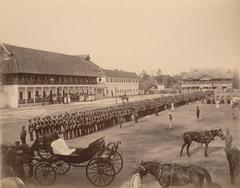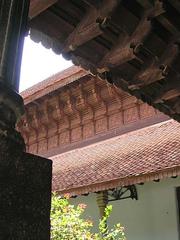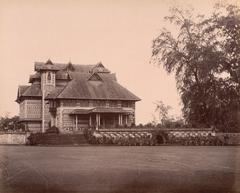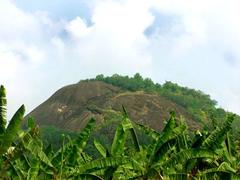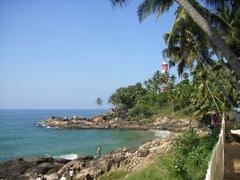
Padmanabhaswamy Temple: Visiting Hours, Tickets, and Historical Significance in Thiruvananthapuram
Date: 03/07/2025
Introduction
Nestled in the heart of Thiruvananthapuram, Kerala, the Sree Padmanabhaswamy Temple is a breathtaking testament to India’s spiritual heritage, architectural mastery, and enduring cultural traditions. Dedicated to Lord Vishnu in his Anantha Shayana (eternal yogic sleep) posture atop the serpent Adi Shesha, the temple stands as a focal point for devotees and history enthusiasts alike. Revered for more than two millennia, its significance is rooted in ancient texts, the grandeur of the Travancore royal family’s stewardship, and the aura of mystery surrounding its legendary treasures.
This comprehensive guide details the temple’s historical evolution, mythological importance, architecture, custodial heritage, and all vital visitor information—including visiting hours, dress code, ticketing, accessibility, and nearby attractions. Whether you are a pilgrim, an architecture aficionado, or a curious traveler, this article equips you with everything needed for a respectful and rewarding visit.
Contents
- Ancient Origins and Historical Evolution
- Mythological Legends and Divine Manifestations
- Architectural and Cultural Significance
- Travancore Royal Family and Temple Administration
- The Mystery of the Temple Vaults and Untold Treasures
- Rituals, Festivals, and Living Traditions
- Visitor Information
- Visiting Hours
- Tickets and Entry
- Dress Code and Etiquette
- Accessibility
- Best Time to Visit
- Nearby Attractions
- Guided Tours and Photography
- Timeline of Key Historical Events
- Frequently Asked Questions (FAQs)
- Conservation Efforts
- Conclusion
- Useful Links and Resources
Ancient Origins and Historical Evolution
The Padmanabhaswamy Temple’s origins are deeply entwined with legend and documented history. Referenced in Tamil Sangam literature (circa 500 BCE–300 CE) as the “Golden Temple,” it has symbolized spiritual and material prosperity for centuries (Hindu Blog). The temple is cited in several Puranic texts, such as the Vishnu Purana and Padma Purana, further underscoring its religious importance (Kerala Tourism).
The current structure was extensively renovated in the 18th century by King Marthanda Varma of Travancore, who famously performed the “Thrippadidanam” ritual, dedicating his kingdom to Lord Padmanabha and establishing the royal family as the temple’s lifelong custodians (Mantrapuja).
Mythological Legends and Divine Manifestations
Mythology enriches the temple’s legacy. According to tradition, Sage Divakara Muni performed penance in the Ananthankadu forest, where Lord Vishnu appeared as a child, ultimately revealing his cosmic form as Anantha Padmanabha reclining on Adi Shesha (Gayatri Heritage). The deity’s unique depiction, visible through three sanctum doors, is said to symbolize this miraculous manifestation. Another legend ties the temple’s origins to a royal couple blessed by Lord Vishnu, thus intertwining the spiritual and royal lineages (Mantrapuja).
Architectural and Cultural Significance
Blending Kerala and Dravidian architectural styles, the temple features a majestic seven-tiered gopuram (gateway tower) that rises nearly 100 feet—an iconic city landmark (Kerala Tour Packages). The sanctum houses an 18-foot-long idol of Lord Vishnu in Anantha Shayana posture, composed of 12,008 salagramas from the Gandaki River and coated with “Katusarkara Yogam,” a unique herbal plaster (Famous Temples of India).
The temple complex, spanning approximately seven acres, is oriented along the East-West axis per ancient vastu shastra principles (arcticle.in). Concentric corridors, intricately carved mandapams, and vivid murals depicting stories from the epics and Puranas contribute to its grandeur (cultureandheritage.org).
Travancore Royal Family and Temple Administration
The Travancore royal family has managed the temple since the 18th century, with the Maharaja as the “Padmanabha Dasa” (servant of Lord Padmanabha). This unique tradition merges spiritual devotion with temporal authority (Official Travancore Website; Wikipedia). In 2020, the Supreme Court of India reaffirmed their custodianship, acknowledging the family’s historical and religious role (Mantrapuja).
The Mystery of the Temple Vaults and Untold Treasures
The temple is famed for its hidden underground vaults, labeled A to H, which have yielded treasures valued at over $22 billion (Famous Temples of India; Viacation). Vault A, opened under court supervision, revealed gold coins, gems, and intricate artifacts, while Vault B remains sealed due to religious beliefs and legal restrictions. Legendary accounts claim that opening Vault B could invoke dire spiritual consequences and that only those versed in powerful mantras may unlock it (Subkuz).
Rituals, Festivals, and Living Traditions
The temple’s spiritual vibrancy is maintained through daily poojas, Vedic chanting, and ritual offerings. Major festivals include:
- Alpashi Utsavam (October–November): A nine-day celebration with grand processions and cultural performances like Kathakali (cultureandheritage.org).
- Panguni Utsavam (March–April): Marked by elaborate rituals, processions, and communal feasts.
- Other Celebrations: Festivals such as Navaratri enliven the temple calendar, drawing thousands of devotees (ayodhyaregistration.com).
These events reinforce the temple’s role as a nucleus of Kerala’s religious and cultural identity.
Visitor Information
Visiting Hours
- Daily: 3:00 AM – 12:00 PM and 5:00 PM – 8:00 PM
- Darshan Slots: Specific slots within these periods; timings may vary during festivals. Check the official website or notices for updates.
Tickets and Entry
- General Entry: Free for Hindus.
- Special Darshan: Tickets (₹150–₹250) enable faster access and may include prasad or pooja thali. Purchase onsite or online (darshansbooking.com).
- Entry Policy: Only Hindus are permitted in the inner sanctum (mystreal.com).
Dress Code and Etiquette
- Men: White mundu/veshti; upper body bare or with angavastram. No shirts, pants, or Western attire.
- Women: Saree, half-saree, or long skirt with blouse/dhoti. No jeans, leggings, or Western wear unless covered by a dhoti.
- Children: Follow adult dress code.
- Dhotis and angavastrams can be rented or purchased nearby (keralatourism.travel).
- Maintain silence, remove footwear, and avoid mobile phones or cameras inside the complex.
Accessibility
- The temple offers ramps and basic assistance for seniors and differently-abled visitors, though certain areas may have steps or uneven floors.
- Priority queueing may be available for the elderly during non-peak hours.
Best Time to Visit
- Ideal Season: October to February, coinciding with major festivals and pleasant weather.
- Peak Hours: Early mornings, weekends, and festival days attract larger crowds. For a peaceful experience, visit during non-peak hours.
Facilities and Amenities
- Cloakroom for shoes and electronics near the entrance.
- Clean restrooms outside the complex.
- Onsite shops for traditional attire and offerings.
- Authorized guides available for in-depth tours.
Nearby Attractions
- Napier Museum
- Kanakakkunnu Palace
- Kovalam Beach
- Kerala State Science and Technology Museum
- Methan Mani Clock Tower
All these sites are easily accessible from the temple and provide a comprehensive cultural experience (gaviya.com).
Guided Tours and Photography
- Guided tours through official Kerala tourism operators are highly recommended for historical and cultural context.
- Photography is strictly prohibited inside the sanctum but allowed in designated outer areas (mystreal.com).
Timeline of Key Historical Events
- Pre-500 BCE: Referenced in Sangam literature.
- 8th Century CE: Myths associate the temple with Sage Divakara Muni.
- 16th–18th Century CE: Major architectural expansion and completion of the gopuram.
- 18th Century: King Marthanda Varma renovates temple and dedicates Travancore kingdom.
- 2011: Opening of vaults reveals treasures.
- 2020: Supreme Court confirms Travancore royal family’s custodianship.
Frequently Asked Questions (FAQs)
Q: What are the temple’s visiting hours?
A: 3:00 AM–12:00 PM and 5:00 PM–8:00 PM; check for festival variations.
Q: Is there an entry fee?
A: General entry is free; special darshan tickets are available for a fee.
Q: Can non-Hindus enter?
A: Entry to the inner sanctum is restricted to Hindus only.
Q: What is the dress code?
A: Traditional attire for all visitors; see guidelines above.
Q: Is photography allowed inside?
A: No, it is strictly prohibited within the temple’s sanctum.
Q: Are guided tours available?
A: Yes, authorized guides are available for historical and cultural tours.
Conservation Efforts
The temple’s management prioritizes preservation through restoration of murals, sculptures, and architectural elements using traditional techniques. Digital archiving and periodic maintenance ensure the temple’s continued grandeur (cultureandheritage.org).
Conclusion
The Sree Padmanabhaswamy Temple stands as a beacon of Kerala’s spiritual, architectural, and cultural heritage. Its blend of ancient rituals, royal patronage, and architectural marvels, coupled with the allure of its legendary treasures, makes it an unmissable destination. Thoughtful planning—respecting the dress code, timings, and temple etiquette—ensures a meaningful and memorable visit.
For up-to-date information, ticket bookings, and guided experiences, use official resources or download the Audiala app. Enhance your visit by exploring nearby attractions and immersing yourself in Thiruvananthapuram’s vibrant heritage.
Useful Links and Resources
- Official Padmanabhaswamy Temple Website
- Kerala Tourism Official Site
- Travancore Royal Family
- Darshan Booking and Timings
- Kerala Tourism Travel Guide
- Culture and Heritage – Festivals & Architecture
- Gaviya – Darshan Timings, Dress Code, Festivals
- Famous Temples of India
- Mantrapuja – History
- Arcticle – Architectural Details
- MysTreal – Temple Rules

